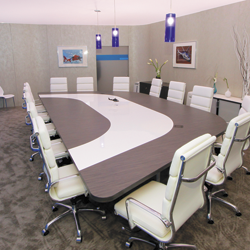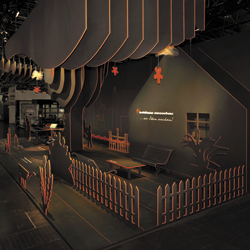system exhibits |
 |
 reviously, in that nebulous middle world between custom-built exhibits and portable pop-ups, exhibit managers who pined for a booth that was faster, better, and cheaper had to settle for two out of three. But an evolution in available systems has brought on a host of display options, even for larger exhibits, that combine the best of both worlds. reviously, in that nebulous middle world between custom-built exhibits and portable pop-ups, exhibit managers who pined for a booth that was faster, better, and cheaper had to settle for two out of three. But an evolution in available systems has brought on a host of display options, even for larger exhibits, that combine the best of both worlds.
Some refer to displays in this category as system exhibits; others call them hybrid custom exhibits, modular system exhibits, portable/modular exhibits, or custom modular exhibits. Manufacturers, suppliers, and exhibitors might use these terms interchangeably, and deciphering their nuanced distinctions when shopping for a display can carry the same difficulty as solving a Rubik's Cube. But the truth is that when dissected, the matter is not as confounding as it might seem. While each moniker implies distinct qualities, such as the degree of modularity or customization available, they all share a few important traits that make them smell just as sweet by any name.
 Modularity: Each of these systems promises to be all things to all people thanks to designs that can grow and shrink according to an exhibitor's needs. Like building blocks, pieces of each system integrate perfectly when added to or rearranged, and conference rooms, kiosks, counters, and more appear and disappear on a whim. System exhibits typically offer quick interchangeability for graphics via universal fasteners that make displays exceedingly versatile. Moreover, wall frames are offered in build-a-wall fashion that allows limitless configurations of size and shape depending on booth space. In terms of functionality, today's modular exhibits can't be beat. Modularity: Each of these systems promises to be all things to all people thanks to designs that can grow and shrink according to an exhibitor's needs. Like building blocks, pieces of each system integrate perfectly when added to or rearranged, and conference rooms, kiosks, counters, and more appear and disappear on a whim. System exhibits typically offer quick interchangeability for graphics via universal fasteners that make displays exceedingly versatile. Moreover, wall frames are offered in build-a-wall fashion that allows limitless configurations of size and shape depending on booth space. In terms of functionality, today's modular exhibits can't be beat.
 Customizability: System exhibits are luring fans of custom-built properties with ever-growing opportunities for customization that include graphics options and the ability to add, relocate, or remove elements such as audiovisual components, storage closets, and even double decks. Starting with a basic structure, exhibitors have myriad options for putting their own tweaks on a property. With that level of customization, exhibitors are able not only to create a display that serves them well, but they are also able to cast off the cookie-cutter stigma from system exhibits. Customizability: System exhibits are luring fans of custom-built properties with ever-growing opportunities for customization that include graphics options and the ability to add, relocate, or remove elements such as audiovisual components, storage closets, and even double decks. Starting with a basic structure, exhibitors have myriad options for putting their own tweaks on a property. With that level of customization, exhibitors are able not only to create a display that serves them well, but they are also able to cast off the cookie-cutter stigma from system exhibits.
 Weight and Size: Modular exhibit components, which are designed to be moved, are much lighter and more compact than their custom-built cousins. In one example from Skyline Exhibits Inc., a custom exhibit packed in 27 crates was replaced by a similarly
sized system exhibit
adequately housed in just seven crates. Aside from decreasing the cubic feet necessary for storage, that compactness is creating budgetary breathing room by saving money on shipping and drayage costs. Weight and Size: Modular exhibit components, which are designed to be moved, are much lighter and more compact than their custom-built cousins. In one example from Skyline Exhibits Inc., a custom exhibit packed in 27 crates was replaced by a similarly
sized system exhibit
adequately housed in just seven crates. Aside from decreasing the cubic feet necessary for storage, that compactness is creating budgetary breathing room by saving money on shipping and drayage costs.
 Appearance: Style is everything when it comes to creating an identity on the show floor, and system exhibits are upping the aesthetic ante with a slew of architectural details and customizable features. More aptly falling in the subcategory of custom modular exhibits, these properties take system components and give companies the ability to further personalize them. The end result is an exhibit that looks custom, often at a fraction of the cost, weight, and setup time required of a traditional custom build. Appearance: Style is everything when it comes to creating an identity on the show floor, and system exhibits are upping the aesthetic ante with a slew of architectural details and customizable features. More aptly falling in the subcategory of custom modular exhibits, these properties take system components and give companies the ability to further personalize them. The end result is an exhibit that looks custom, often at a fraction of the cost, weight, and setup time required of a traditional custom build.
As you'll see from the examples, gone is the lackluster sameness of anything that is not a custom exhibit, and in its place is a modern market filled with imaginative possibilities. Yes, system exhibits and their kin can still be thought of as off-the-shelf products to a certain degree, but only to the extent that manufacturers have the framework ready to purchase. From that point, you're only limited by your imagination. So to help you seek out a system that's a perfect fit for your brand, here are five options currently available. E
|
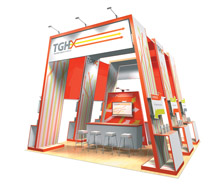 Envoy Exhibit System Envoy Exhibit System
Extreme modularity is the hallmark of the Envoy Exhibit System by Skyline Exhibits Inc., with reconfigurable components capable of creating anything from a 10-by-10-foot in-line booth to a sprawling 70-by-100-foot island exhibit. Featuring modern lines, Envoy boasts an architectural appeal that is deceptively simple to assemble with just an Allen wrench and a ladder. Interchangeable graphics slide into channels with a silicone edge, and board-mounted graphics can be affixed in minutes to create a custom exhibit appearance. With components available to address challenges related to wire management, merchandising, and AV, Envoy offers the sleekness of a built-to-order display without the bulk or weight.
Provider: Skyline Exhibits Inc., St. Paul, MN, 800-328-2725, www.skyline.com |
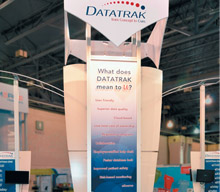 Velocity Velocity
Flexibility with flair defines the ultra-modular components of the Velocity line by Nimlok, an exhibit system that can be reconfigured on the spot, and can have all new graphics in place in just five business days. But for all its modularity, Velocity's bold elements look more like its custom-built neighbors than an exhibit that assembles with hex keys in 12 to 16 hours and comes out of 170 cubic feet of storage. To create its polished look, Velocity uses a combination of dye-sublimated pillowcase graphics, rigid graphics accents, and silicone-edge graphics technology, and offers
quick customization with a selection of AV supports and shelving. The result is a modular system
exhibit that can shrink from a 20-by-20-foot display to a 10-by-10-foot booth overnight, and expand into new configurations for years to come thanks to a robust extrusion frame and universally sized components.
Provider: Nimlok, Niles, IL, 800-233-8870, www.nimlok.com
|
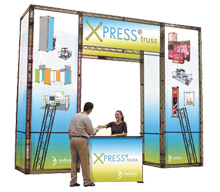 Xpress Truss Xpress Truss
With the modularity of Tinker Toys and pieces that are just as easy to put together, Xpress Truss is making a name for itself as a stylish and economical alternative to a custom-built display. Registering a base weight of just 250 pounds, Xpress Truss is a breeze to handle on the show floor. It can be erected effortlessly to heights of 20 feet and configured into countless structures. But the Xpress Truss isn't just for the big boys on the trade show floor, as it can also be configured for use as a tabletop display. Component pieces come in lightweight aluminum modules from 4 to 48 inches in length that connect with knobs for quick assembly into virtually limitless structures, including overhead spans of up to 15 feet. Fabric graphic panels attach using rod pockets at the top and bottom with the help of aluminum rods and clips, though other media can be attached using clips, hook-and-loop fasteners, or magnetic strips.
Provider: Radius Display Products, Dallas, 800-322-7429, www.radiusdisplay.com |
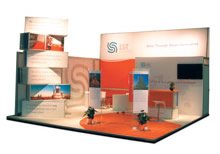 Agam System Agam System
For the ultimate in exhibiting flexibility, Moose Exhibits' Agam System offers a hybrid custom/system/rental option that's low on weight and long on configurations. Whether for an in-line, island, or peninsula booth, the system's fabric and direct-print graphics and interchangeable components can be rearranged to accommodate traffic and visibility in exhibits from 10-by-10 feet to many times that size. A back wall, overhead signage, stackable graphics boxes, and Plexiglas partitions are just a few of the elements
exhibitors can mix and match to meet their needs. The base system fits in two 4-by-4-by-10-foot crates and assembles with a set of Allen wrenches and a rubber mallet.
Provider: Moose Exhibits, Norcross, GA, 888-396-6673, www.mooseexhibits.com |
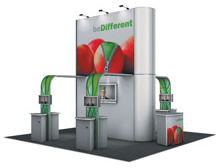 beDifferent beDifferent
Exhibitors looking to curb installation-and-dismantle costs but keep a custom-build feel are turning to beDifferent by e4 Design, a tool-less wonder that combines a system approach with custom touches. The modular components of beDifferent assemble via connectors that snap into place like a giant Lego set. Whether in a 10-by-10-foot exhibit or a structure three times that size, wall sections can be relocated to different places and heights at will, and wall sections can accommodate a variety of in-fills, from fabric to laminate to Plexiglas. Hook-and-loop fasteners and silicone-edge technology make swapping graphics a minute-long job, and a whole 20-by-20-foot exhibit can be erected in 12 labor hours out of two 4-by-4-by-8-foot crates.
Provider: e4 Design, Norcross,
GA, 800-316-4660, www.efourdesign.com |

Though each system has a
variety of customizable features that change its specifications, this comparison chart features data on each system's most typical base configuration for
a 20-by-20-foot exhibit. |


Envoy Exhibit System
|


Velocity |


Xpress Truss
|


Agam System
|

 beDifferent beDifferent
|
Weight
(including crates): |
2,200 pounds |
1,900 pounds |
250 pounds |
1,900 pounds |
1,880 pounds |
| Storage: |
One 2-by-4-by-8-foot crate and
one 4-by-4-by-8-foot crate |
One 9-by-4-by-3-foot crate and
one 4-by-5-by-5-foot crate
|
Four 3-by-4-foot-by-16-inch crates |
Two 4-by-4-by-10-foot crates |
Two 4-by-4-by-8-foot crates
|
| Tools Required: |
Allen wrench and ladder |
Set of basic hex keys |
No tools required |
Allen wrench and rubber mallet |
No tools required |
| Assembly Time: |
50 labor hours |
14 labor hours |
2 labor hours |
32 labor hours |
12 labor hours |
| Graphics: |
Silicone edge, secure board mounted on standoff frames |
Silicone edge, rigid graphics accents |
Rod pockets with aluminum rods and clips |
Dye sublimation, tensioned fabric, direct-print graphics |
Silicone edge, hook and loop |
|
|
|




 reviously, in that nebulous middle world between custom-built exhibits and portable pop-ups, exhibit managers who pined for a booth that was faster, better, and cheaper had to settle for two out of three. But an evolution in available systems has brought on a host of display options, even for larger exhibits, that combine the best of both worlds.
reviously, in that nebulous middle world between custom-built exhibits and portable pop-ups, exhibit managers who pined for a booth that was faster, better, and cheaper had to settle for two out of three. But an evolution in available systems has brought on a host of display options, even for larger exhibits, that combine the best of both worlds.










